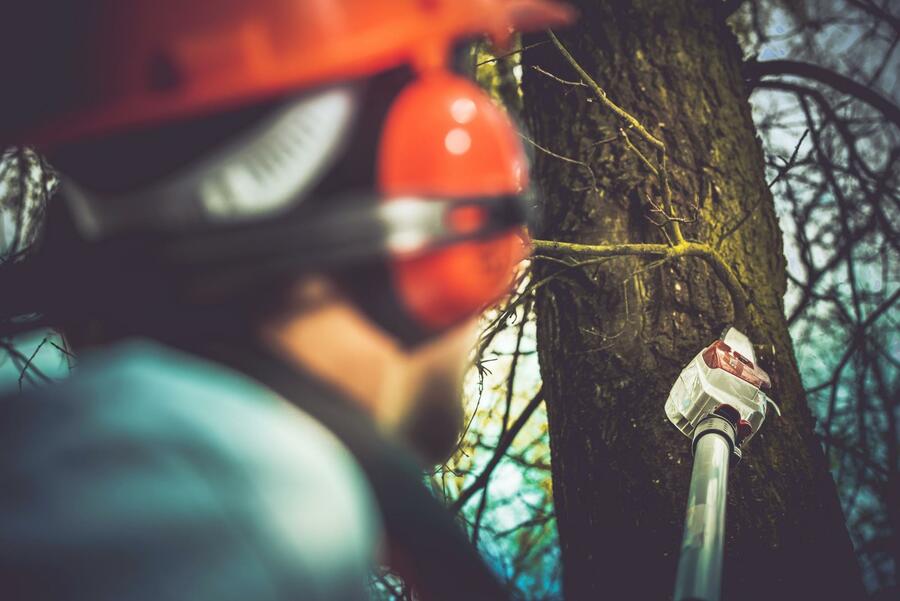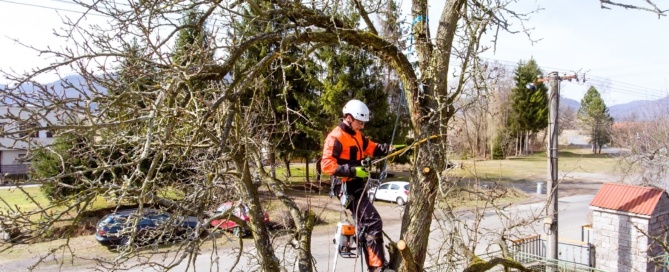Monthly Archives:
What Is a Tree Inspection? (And Why You Need One)
When it comes to living a safe and comfortable life, inspections are essential. Think about it. From buying a home to maintaining a car, inspections are a standard and widespread practice. Even restaurants, aircraft, and your own teeth require routine inspections.
While these things are extremely different, they all need regular checkups to stay safe. That’s because inspections are designed to detect existing and potential issues before they turn into bigger problems.
Your trees are no exception. Yes, that’s right: Trees need inspections, too. When performed by a professional tree expert, a tree inspection will help your trees thrive in the best way possible.
What is a Tree Inspection?
A tree inspection involves a careful examination of your trees. It’s done by arborists, like the ones at Friendly Tree.
During the inspection, your arborist will evaluate the tree’s structure and surrounding soil. They’ll also determine the tree’s overall health by inspecting its bark, branches, and more.
Why You Need Tree Inspections
A tree inspection is like a routine checkup with the doctor. It measures the most basic aspects of health, which can indicate bigger problems or risks. Specifically, a tree inspection can:
1. Diagnose Tree Infections Early
Like an annual doctor’s appointment, inspections look for signs of disease. This includes infections caused by bacteria, fungi, or insects.
A certified arborist knows precisely what to look for. They’ll consider regional diseases and pests, which can help them diagnose issues sooner rather than later.
2. Identify Structural Damage
Physical damage due to construction, storms, or incorrect tree pruning can be identified during an inspection. This is crucial for the tree’s health, as structural problems can make it difficult for the tree to take in oxygen and water.
3. Improve Safety
By identifying disease and damage, a tree inspection protects both humans and pets. A damaged tree, after all, is more likely to break or fall. This poses a hazard to residents and buildings alike.
4.Determine Watering Needs
If you’ve never consulted a tree arborist, or if you recently planted a new tree, a tree inspection will help you plan a proper watering routine.
An arborist can create a personalized watering guide based on the type of tree, its age, and upcoming seasons. Depending on your previous watering habits, this might involve more or less water, or a specific schedule.
4.Establish Soil Requirements
Likewise, a tree inspection helps you determine the best soil for your trees. Good soil is vital for healthy and happy trees. The examination can also shed light on the ideal fertilizer and mulch for your trees.
Friendly Tree Offers Comprehensive Tree Inspections in New Jersey
In a nutshell, tree inspections are essential for tree health and safety. It also doesn’t hurt that they’ll save you money in the long run, as each inspection allows you to fix issues while they’re still manageable.
After the inspection, the arborist will propose the next best steps. They can also provide guidelines for various tree care practices, such as pruning.
To schedule an inspection, contact Friendly Tree at (973) 678-8888. Our professional New Jersey tree service is available throughout Essex, Morris, Union, Bergen, Passaic, Hudson, Middlesex, and Somerset counties.
Winter Tree Care 101: How to Protect Your Trees This Winter
With the cold weather around the corner, it’s time to start thinking about winter tree care.
Now, that’s not to say trees aren’t resilient. They go dormant in the winter, much like hibernating animals. Even then, the icy temperatures and frosty conditions is still stressful for trees.
This is especially important for recently planted trees, which are not fully established. These trees are more susceptible to winter damage because they haven’t developed a solid root system.
Fortunately, with enough planning and preparation, you can help your beloved trees survive winter.
Add Mulch
Mulching isn’t just for landscaping projects during the warmer months. Come winter, mulch insulates your trees by increasing the temperature of the soil. This stops the soil from cracking, which protects the roots. Essentially, mulch is a blanket for trees.
Timing is everything, though. Mulch just before the ground freezes. Otherwise, pests and rodents will turn the mulch into their new winter home.
When you do mulch, add a two- or three-inch layer under your tree’s drip line. Avoid mulching too deep or up against the trunk. If you’re unsure how to mulch the right way, contact a professional tree company like Friendly Tree.
Water Throughout Fall
Again, preparation is key. During the fall season, make sure your trees are regularly watered. This is even more vital for newly planted trees.
Continue watering the trees until the ground freezes — around late October or November. From there, water them once or twice a month. You should also only water them under the following conditions:
- The temperature is 40 degrees Fahrenheit or higher
- There isn’t any ice or snow on the ground nearby
- It’s early in the day, which allows enough time for absorption
If you have evergreen trees, water them during winter droughts. Since they lose moisture through their needles, these trees need to store more water.
Fall Pruning
Winter tree branch care starts with smart fall pruning. Before the new season begins, remove weak and dying branches. This will minimize future breakage, especially during intense window and ice buildup.
Fall pruning not only improves the aesthetics of your tree, but it makes them safer too. As always, work with a certified arborist to ensure that your trees are properly pruned.
Wrap Tree Trunks
To protect your trees from the frigid winter nights, use winter tree wraps. These wraps will keep tree trunks warm during the chilly weather.
They’ll also prevent sunscald, a condition that damages the trunk. Sunscald happens when the tree trunk freezes at night, then thaws under the winter sun. When it freezes again at night, the cells in the bark can burst and cause cracking.
Tree wraps also stop rodents, rabbits, and other animals from chewing on your tree trunks.
It’s best to install the tree wraps in late fall or early winter, before the first freeze. You can leave them on until late winter or early spring.
Remove Snow
While you’re shoveling the driveway, don’t forget to remove the snow from tree branches. Otherwise, snow can build up and break branches.
Gently remove the snow with a soft broom. You can also carefully push the branch upward until the snow falls off. If the branch has ice, spray it with warm water through a garden hose. Never try to remove ice from a branch.
Friendly Tree Will Help You Weather The Winter Season
Although New Jersey winters can be brutal, it’s possible to protect your trees from seasonal damage. It comes down to proper winter tree care and being vigilant about tree maintenance.
If you’re not sure where to start, get in touch with Friendly Tree. Our experienced New Jersey arborists can examine your trees and offer winter survival tips according to their age, health, and species. With this personalized guidance, you can give your trees the best protection possible during the frosty weather.
To schedule a consultation, contact Friendly Tree at (973) 678-8888.
What Are Air Spade Services?
Root excavation is one of the most important components of tree care. The tree’s root system, after all, can’t be seen above ground level. An arborist needs to remove the soil around the roots in order to properly examine the root tissue.
Fortunately, it’s possible to do this without injuring the roots. The answer is the Air Spade, a state-of-the-art tool that Friendly Tree is proud to use. Let’s look at how Air Spade services work and why they are so useful.
Air Spades for Root Excavation
The Air Spade is an excavation device that uses compressed air to remove soil. It’s powerful enough to handle heavy materials like hard clay or clumps of soil. At the same time, it’s gentle enough to safely use around sensitive roots.
The device is essentially a long stick, or wand, with an adjustable nozzle. The wand is connected to an air compressor, which sends high-pressure air through the wand. When the air is released from the nozzle, it breaks apart lumps of soil.
When is an Air Spade Used?
Air Spades are used for removing soil around the base of a tree. This exposes the tree’s complex root system, which is ideal for situations like:
- Preparation for root inspection
- Diagnosis of tree concerns or diseases
- Removal of excess soil after construction projects
- Preparation for various treatments (such as fungicides)
- Excavation of trees that were planted too deeply (a common occurrence)
- Digging trenches for gas, electric, utility, and sprinkler lines without cutting roots
How an Air Spade Protects a Tree
Since the root system is underground, it’s impossible to inspect or handle the roots without digging up the surrounding soil. This is traditionally done with a hand spade or another mechanical technique.
However, it can be a tedious process. It can also result in root damage and endanger the health of the tree.
Air Spades offer a safer, more efficient method. The high-pressure air breaks apart soil without harming the root tissue. As a bonus, the process is quick, so it saves time for both the arborist and property owner.
The only drawback is that the Air Spade is quite loud. The noise is caused by the air compressor and high-pressure air. Otherwise, an Air Spade will only benefit your tree in the long run.
Friendly Tree Offers Air Spade Services in New Jersey
If you’re in need of root excavation, contact Friendly Tree. Our New Jersey tree experts are skilled in professional Air Spade services. During the excavation process, we can also examine your tree’s health and diagnose any plant concerns.
Since 1989, Friendly Tree has offered tree services throughout northern New Jersey. Our team serves Essex, Morris, Union, Bergen, Passaic, Hudson, Middlesex, and Somerset counties. When you’re ready to schedule a consultation, contact Friendly Tree at (973) 678-8888.
Why Are My Tree’s Leaves Turning Yellow?
It goes without saying that New Jersey autumns are beautiful. It’s all thanks to the gorgeous medley of yellow, orange, and red leaves. You might even spot a few purple ones if you’re lucky.
While we adore these amazing colors, it can be concerning to see them off-season. This is especially true with yellow leaves, which typically indicate a problem. Naturally, if it isn’t fall quite yet, you might wonder why your leaves are turning yellow.
Here are potential causes of those yellow leaves:
1. Lack of Water
Insufficient water is a common cause of yellowing leaves. This is likely if you have automated water sprinklers, which may not reach all of your plants.
A dehydrated tree might have yellow leaves or leaves with brown tips. The leaves might also be dry, wilted, or curling.
To determine if a tree is underwatered, check the soil six to eight inches deep. It should be moist and somewhat cool. But if the soil is dry and crumbly, the tree is thirsty.
2. Too Much Water
Likewise, overwatering can make leaves turn yellow or pale green. Too much water deprives the roots of oxygen, which suffocates and kills them. As a result, the damaged roots are unable to deliver nutrients and oxygen to the leaves.
You can tell a tree is overwatered if the area around is frequently wet. To remedy the problem, take a break from watering your tree. If you have an automated sprinkler, make sure most of the water isn’t falling onto one plant. An environmental factor like a small hill or gutter might also be directing water toward a single tree.
3. Fungal, Bacterial, Viral Disease
A tree with yellow leaves might have an infection. You can identify the pathogen at play by observing other signs and symptoms.
Generally, fungal diseases cause yellow leaves and/or brown spots. There might also be a powdery mildew substance on the leaves. Bacterial diseases, on the other hand, typically cause dark spots with yellow “halos.” Viral diseases cause yellow and crinkly leaves.
If you think your plant is infected, ask an expert tree provider to diagnose the problem.
4. Pest Infestation
Yellow, hole-ridden leaves are likely caused by a pest infestation.
Insects like aphids and mealybugs are notorious for attacking trees. These bugs feed on nutrient-rich sap, making it difficult for a tree to produce enough chlorophyll.
Again, like pathogenic diseases, tree pest infestations are best handled by professionals. It’s the best way to properly control the invasion and prevent it from spreading.
5. Nutrient Deficiency
Trees, like humans, need enough minerals to stay healthy. Specifically, trees need nutrients like:
- Iron
- Zinc
- Magnesium
- Manganese
- Boron
If a tree doesn’t get enough of these nutrients, it will have difficulty making chlorophyll, the pigment that makes leaves green. This causes a condition called chlorosis, which turns leaves yellow or yellow-white.
But this isn’t just a superficial issue. A plant needs chlorophyll to turn sunlight into energy and food. Without sufficient chlorophyll, the tree will starve and die.
To identify chlorosis, look at the leaves’ veins. The area between the veins typically turn yellow first, while the actual veins stay green. If the chlorosis is severe, the leaves will be completely yellow with brown spots.
You can reverse the issue by mixing supplements into the soil. An expert tree provider like Friendly Tree can determine which supplements are necessary.
6. Herbicides
Finally, some herbicides lead to yellowing. These weed killers contain chemicals that can disrupt chlorophyll production. Consequently, the leaves turn yellow and the plant is unable to continue photosynthesis.
The yellowing might appear in streaks or spots. In some cases, the veins may also turn pink or purple.
Let Friendly Tree Diagnose All Your Tree Problems
If you’re not sure why your leaves are turning yellow, consult the professionals at Friendly Tree. As you can see, there are many potential causes, so it’s important to work with an expert.
We can examine your tree and diagnose the problem before it progresses. Most importantly, our tree technicians can explain how to prevent the issue from coming back.
Friendly Tree offers tree services in New Jersey. Since 1989, we’ve proudly served customers throughout northern New Jersey, including Montclair, Madison, Union, Morristown, and more.
Contact Friendly Tree at (973) 678-8888 to get a quote or schedule a consultation.
Why Your Tree Company Should Have Insurance 2
When it comes to hiring a tree company, there are many things to look for.
For starters, you should consider their experience and reviews of former customers. You’ll also want to learn about their specific services, like tree pruning or tree planting. And then, of course, you’ll want to consider the actual cost of their professional services.
But before you can move forward, there’s one more box that needs to be checked: insurance.
After all, if you hire a tree company without full insurance coverage, you’ll simply create a recipe for disaster.
In this article, we’ll break down the reasons why your tree company should always have insurance.
The Nature of Working with Mother Nature
First, it helps to understand the liability that comes with tree service work.
The tree care field is one of the most dangerous industries in the country. From extreme heights to electrical lines, workers are regularly exposed to high-risk situations. Tree care employees are also required to operate sharp and heavy equipment.
The job is even more dangerous after storms, when conditions are more slippery than usual.
Most importantly, Mother Nature is unpredictable. A dying tree branch, for example, can fall without warning. This is why it’s crucial to work with an experienced and knowledgeable tree service company like Friendly Tree.
Insurance Protects Both You and the Tree Company
Due to the dangerous nature of tree care, it’s critical to hire a company that has insurance. Specifically, they should have general liability insurance and workers’ compensation.
If a tree worker is injured on your property, workers’ compensation will cover their medical bills. But if they get hurt on your property and don’t have insurance, the company or worker can potentially sue you.
Plus, if you knowingly hire a company without insurance, your home insurance probably won’t pay the claim.
Insurance also protects against structural damages. For instance, if a tree worker prunes a tree and a heavy branch falls on your roof or car, their insurance will cover it.
Of course, no one wants accidents or injuries to happen. However, anything is possible, and it’s always best to be prepared.
Your Tree Company Should Also Have Certified Arborists and Tree Experts
In addition to insurance, your tree company should also have certified and licensed tree experts.
These experts have completed a high standard of training, licensing, and certifications. This ensures that they’ll get the job done — and do it right.
It also means that they have received proper safety training, thus reducing the risk of injuries and accidents.
Keep this in mind if another business, like a landscaping company, attempts to offer you tree services. While they might have insurance, their workers aren’t professional trained to handle the job.
Moreover, their insurance likely won’t cover the same scenarios tree workers encounter each day.
Call the Friendly Experts at Friendly Tree
As you can see, there are many reasons why your tree company should have insurance. It protects everyone involved, from the client to the business.
With Friendly Tree, you won’t have to wonder. We’re a fully insured tree company with years of professional experience. Since 1989, our team of certified arborists has proudly provided tree service in northern New Jersey.
We can’t wait to serve you, too. To learn more about our expert tree services, contact us at (973) 678-8888.
Recent Posts
Archives
- August 2022
- June 2022
- May 2022
- April 2022
- March 2022
- February 2022
- January 2022
- December 2021
- November 2021
- September 2021
- August 2021
- July 2021
- June 2021
- April 2021
- March 2021
- February 2021
- January 2021
- December 2020
- November 2020
- October 2020
- September 2020
- August 2020
- July 2020
- June 2020
- May 2020
- April 2020
- January 2020
- December 2019
- November 2019
- October 2019
- September 2019
- August 2019
- July 2019
- June 2019
- May 2019
- April 2019
- March 2019
- February 2019
- November 2018
- September 2018
- August 2018
- July 2018
- June 2018
- May 2018
- April 2018
- February 2018
- September 2016
- August 2016
- July 2016
- June 2016
- May 2016
- April 2016
- November 2015
- August 2015
- March 2015






Recent Comments